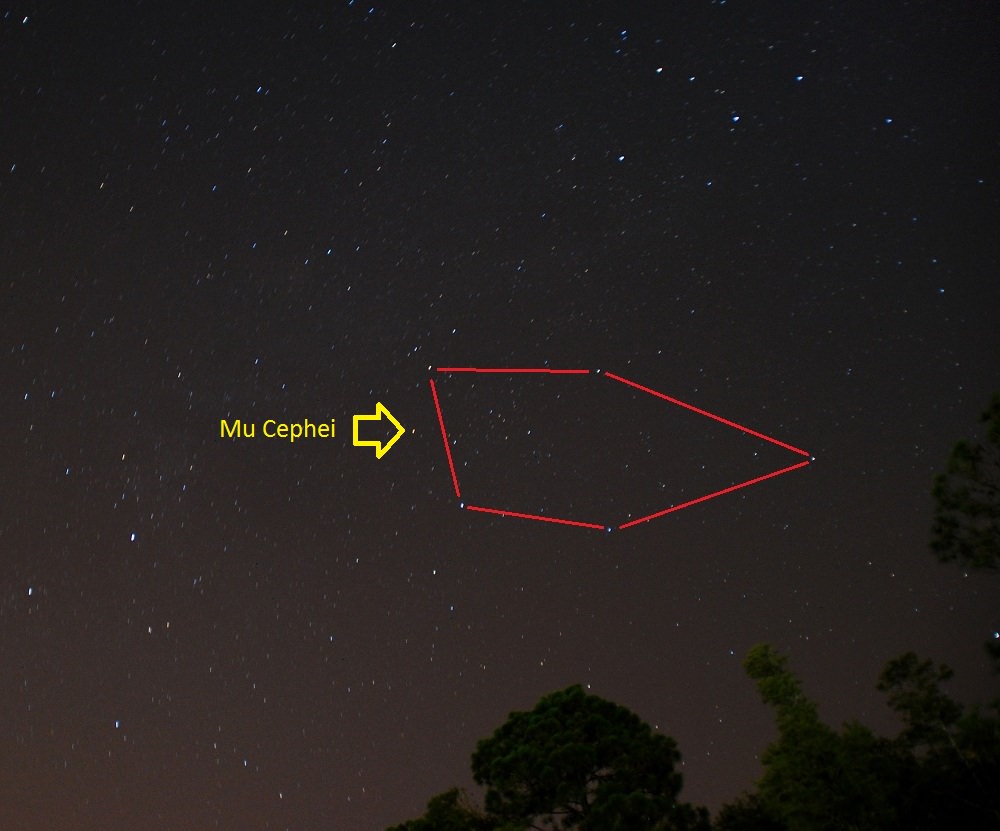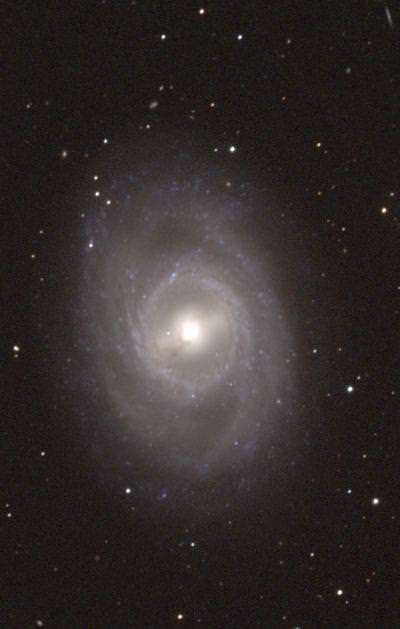[/caption]Greetings, fellow SkyWatchers! It’s shaping up to be a great week to enjoy astronomy. For both hemispheres, the Virginid Meteor shower is underway and its peak occurs late Monday night / early Tuesday morning. Need more celestial fireworks? Then keep looking up as the “April Fireballs” will be visiting, with their peak beginning about a week from today and lasting for 24 days. Even if you only catch one of these bright travelers as they sparkle across the starry sky, it will make your night! But hang on, there will be plenty to explore. Bright stars and bright planets are featured – as well as some of the season’s best galaxies. Keep your telescope out and don’t get spooked, because the “Ghost of Jupiter” will be a challenge object! If you want to know more about astonomy history, and what you can see with just your eyes and your optics, then meet me in the back yard…
Monday, April 9 – Tonight let’s take a journey towards the 25th brightest star in the night sky – 1.3 magnitude, Alpha Leonis. Regulus, known as “The Little King,” is the brightest star in Leo. At 77 light-years away, this star is considered a “dwarf” despite shining with a visible light almost 150 times that of Sol. The orange-red giant Arcturus and the blue white “dwarf” Regulus both share a common absolute magnitude very close to 0. The reason the two stars shine with a similar intrinsic brightness – despite widely different physical sizes – is Regulus’ photosphere is more than twice as hot (12,000 C) as Arcturus. While observing Regulus, look for a distant companion of magnitude 8.5. Normally low powers would best concentrate the companion’s light, but try a variety of magnifications to help improve contrast. For those with large aperture scopes, look for a 13.1 magnitude “companion’s companion” a little more than 2 arc seconds away!
Tuesday, April 10 – Be sure to get up before dawn to enjoy the Virginid meteor shower. The radiant point will be near Gamma in the bowl of Virgo. The fall rate of 20 per hour is above average for meteor showers, and with the Moon partially out of the equation this morning, you’re in for a treat!
Tonight, let’s have a look at Arcturus – a star whose distance from the Earth (10 parsecs) and radial velocity (less than 200 meters per second) can almost be considered a benchmark. By skydark you will see 0.2 magnitude, Arcturus – the brightest star in Bootes and 4th brightest star in the night sky – some 30 degrees above the eastern horizon. Apparent to the eye is Arcturus’ orange color. Because a star’s intrinsic luminosity relates to its apparent brightness and distance, Arcturus’ absolute magnitude is almost precisely the same as its apparent magnitude. Just because Arcturus’ radial velocity is nearly zero doesn’t mean it isn’t on the move relative to our Sun. Arcturus is now almost as close as it will ever get and its large proper motion – perpendicular to our line of sight – exceeds 125 kilometers per second. Every 100 years Arcturus moves almost 1 degree across the sky!
Since you’ve looked at a red star, why not look at a red planet before you call it a night? Mars is still making a wonderful apparition. Have you noticed it dimming even more? Right now it should be about magnitude -0.5. You may have noticed something else about Mars in the eyepiece, too… It’s getting smaller!
Wednesday, April 11 – Today is the birthday of William Wallace Campbell. Born in 1862, Campbell went on to become the leader of stellar motion and radial velocity studies. He was the director of Lick Observatory from 1901 to 1930, and also served as president of the University of California and the National Academy of Sciences. Also born on this day – but in 1901 – was Donald H. Menzel – assistant astronomer at Lick Observatory. Menzel became Director of Harvard Observatory, an expert on the Sun’s coronosphere and held a genuine belief in the extraterrestrial nature of UFOs. Today in 1960, the first radio search for extraterrestrial civilizations was started by Frank Drake (Project Ozma). In 1986, Halley’s Comet closed within 65 million kilometers of the Earth – as close as it would get.
Tonight, why don’t we honor Campbell’s work as we try taking a look at a variable ourselves? RT (star 48) Aurigae is a bright cephid that is located roughly halfway between Epsilon Geminorum and Theta Aurigae. This perfect example of a pulsating star follows a precise timetable of 3.728 days and fluxes by close to one magnitude.
Thursday, April 12 – Today in 1961, Yuri Gagarin made one full orbit of the Earth aboard Vostok 1, while also becoming the first human in space. Also today (in 1981) Columbia became the first Space Shuttle to launch.
Break out the telescope tonight and launch your way towards Iota Cancri – a fine wide disparate double of magnitudes 4.0 and 6.6 separated by some 30 arc seconds. This true binary is so distant from one another that they take over 60,000 years to complete a single orbit around their common center of gravity! Located slightly less than a fist’s width due north of M44, this pair is about 300 light years distant. Both stars shine with a light considerably brighter than our Sun and observers may note a subtle gold and pale blue color contrast between them.
Friday, April 13 – With no early evening Moon to contend with, this is a fine opportunity to have a look at a group of galaxies between Leo’s paws. Start at Regulus and look due east toward Iota Leonis. Halfway between the two (less than a fist from Regulus) and two finger-widths northeast of Rho Leonis, you’ll encounter Messier Galaxies M95 (Right Ascension: 10 : 44.0 – Declination: +11 : 42) and M96 (Right Ascension: 10 : 46.8 – Declination: +11 : 49) – both within the same low power field of view. At magnitude 9.2, the brighter – and slightly rounder – M96 lies northeast of 9.7 magnitude, M95. Pierre Mechain discovered both galaxies on March 20, 1781 and Messier added them to his catalog 4 days later. These two galaxies are two of the brightest members of the Leo I galaxy group located some 38 million light-years away.
To see another Messier member of the Leo I group, center on M96 and shift the galaxy south. From the north side of the low power field, the 9.3 magnitude galaxy M105 (Right Ascension: 10 : 47.8 – Declination: +12 : 35), nearby 10th magnitude NGC 3384 (Right Ascension: 10 : 48.3 – Declination: +12 : 38), and 12th magnitude NGC 3389 (Right Ascension: 10 : 48.5 – Declination: +12 : 32) will come into view. M105 was discovered by Mechain on the night Messier catalogued M95 and 96 but was not formally added to Messier’s catalog. Based on Mechain’s observing notes, Helen Sawyer Hogg added it to Messier’s list in 1947 – along with galaxy M106 and globular cluster M107. Mechain failed to notice M105’s bright neighboring galaxy – NGC 3384. NGC 3384 is actually slightly brighter than the faintest Messier discovered – M91.
We’re not done yet! If you center on M105 and shift due north less than a degree and a half you will encounter 10th magnitude NGC 3377 (Right Ascension: 10 : 47.7 – Declination: +13 : 59) – a small elongated galaxy with a stellar core. There are a dozen galaxies visible to moderate amateur instruments (through magnitude 12) in the Leo I region of the sky!
Saturday, April 14 – Today is the birthday of Christian Huygens. Born in 1629, the Dutch scientist went on to become one of the leaders in his field during the 17th century. Among his achievements were promoting the wave theory of light, patenting the pendulum clock, and improving the optics of telescopes by inventing a new type eyepiece and reducing false color through increasing the focal length of refractor telescopes. Huygens was the first to discover Saturn’s rings and largest satellite – Titan. Of the rings, Huygens said, “Saturn: encircled by a ring, thin and flat, nowhere touching, and inclined to the ecliptic.”
Wanna’ check Saturn out? It will be rising in the constellation of Virgo not long after the sky begins to turn dark. If you’re not sure of which “star” it is, just wait for awhile and you’ll find it about a fistwidth northwest of bright, blue/white Spica. Be sure to check out the ring system! Right now they have a very nice southern tilt which will allow you a great view of the shadow of the planet on the rings – and the shadow of the rings on the planet. If the atmosphere will allow, power up! Something you may never have thought of looking for could be happening… Can you see the planet’s edge through the Cassini division? Be sure to look for wide orbiting Titan and some of Saturn’s smaller moons slipping around the ring edges.
Tonight our challenge is also planetary – but it’s the planetary nebula – the “Ghost of Jupiter”. Begin by identifying the constellation of Hydra. Starting at Alpha Hydrae, head east about a fist’s width to find Lambda within a field of nearby fainter stars. Continue less than a fist southeast and locate Mu. You’ll find the “Ghost of Jupiter” (NGC 3242) lurking in the dark less than a finger-width due south. At magnitude 9, the NGC 3242 (Right Ascension: 10 : 24.8 – Declination: -18 : 38) gives a strikingly blue-green appearance in even small scopes – despite being more than 1500 light years away.
Sunday, April 15 – Tonight keep a watch for the “April Fireballs.” This unusual name has been given to what may be a branch of the complex Virginid stream which began earlier in the week. The absolute radiant of the stream is unclear, but most of its long tails will point back toward southeastern skies. These bright bolides can possibly arrive in a flurry – depending on how much Jupiter’s gravity has perturbed the meteoroid stream. Even if you only see one tonight, keep a watch in the days ahead. The time for “April Fireballs” lasts for two weeks. Just seeing one of these brilliant streaks will put a smile on your face!
And if you can’t take your eyes off Leo, then there’s good reason. The combination of Theta Leonis, Regulus and Mars certainly calls attention to itself!
While we’re out, let’s journey this evening towards another lovely multiple system as we explore Beta Monocerotis. Located about a fist width northwest of Sirius, Beta is one of the finest true triple systems for the small telescope. At low power, the 450 light year distant white primary will show the blue B and C stars to the southeast. If skies are stable, up the magnification to split the E/W oriented pair. All three stars are within a magnitude of each other and make Beta one of the finest sights for late winter skies.
If you hadn’t noticed, Saturn is at opposition tonight, meaning it will be viewable from dusk until dawn. Be sure to check out the “Ring King” – but wait until it has risen well above the lower atmosphere disturbance for a superior view!
Until next week, I wish you clear and steady skies!



